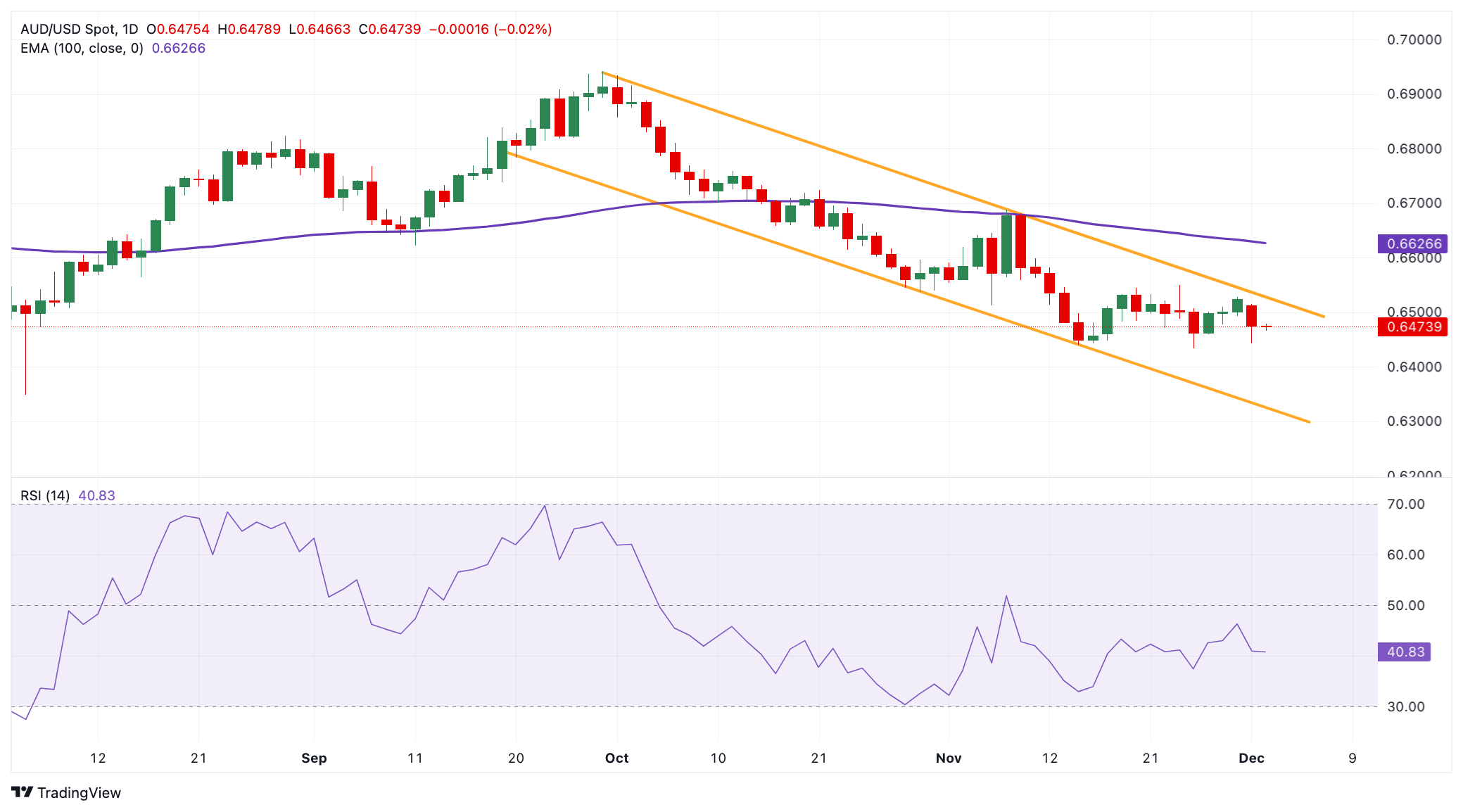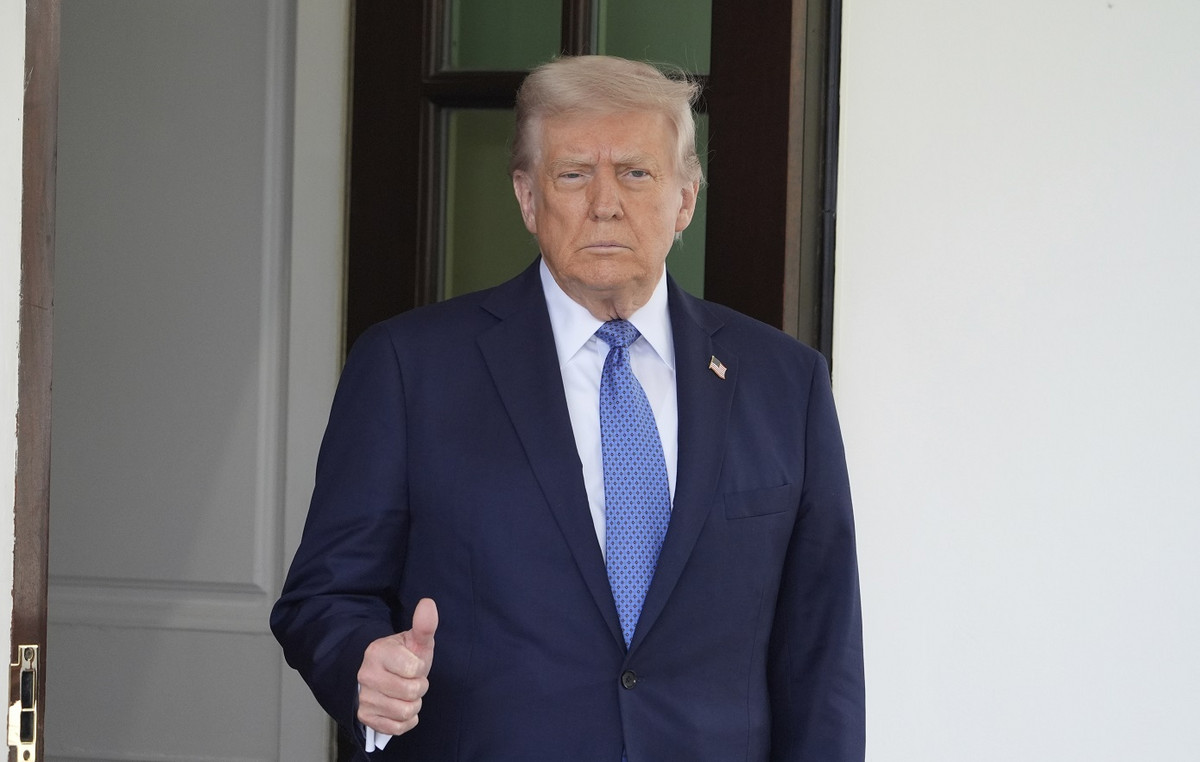- The Australian Dollar eases in the early Asian session on Tuesday.
- Renewed USD demand and Trump’s tariff threats weigh on the pair; RBA’s hawkish expectations could limit its decline.
- Investors prepare for October JOLTs in the US and Fed speeches on Tuesday.
The Australian Dollar (AUD) extends its decline near 0.6470 during the early Asian session on Tuesday. US Dollar (USD) strength to three-day highs drags the pair lower. Furthermore, the eruption of a global trade war under the return of US President-elect Donald Trump could put some selling pressure on the Aussie.
However, hawkish comments from Reserve Bank of Australia (RBA) Governor Michele Bullock could help limit AUD losses. RBA Governor Bullock said last week that core inflation remains too high to consider short-term interest rate cuts, increasing demand for the AUD. Later on Tuesday, October JOLTs job openings in the US will be posted. Additionally, Adriana Kugler and Austan Goolsbee of the Federal Reserve (Fed) are scheduled to speak. Australia’s Gross Domestic Product (GDP) for the third quarter (Q3) will be closely watched on Wednesday.
Australian Dollar weakens amid Trump’s tariff threats
- Australian retail sales rose 0.6% month-on-month in October, compared with a 0.1% rise in September, according to the Australian Bureau of Statistics (ABS) on Monday. The reading was above estimates for 0.3% growth.
- The US ISM Manufacturing PMI rose to 48.4 in November from 46.5 in the previous one. This reading was stronger than the market expectation of 47.5.
- Atlanta Fed President Raphael Bostic said Monday that he is undecided about whether a rate cut is necessary at the December meeting, but still believes Fed officials should continue lowering rates in the coming months. according to Bloomberg.
- New York Fed President John Williams stated Monday that Fed officials will likely need to cut interest rates further to move policy to a neutral stance now that risks to inflation and employment have eased. balanced more.
- Fed Governor Christopher Waller signaled he was leaning toward supporting an interest rate cut at the December meeting amid expectations that inflation will continue to decline toward the Fed’s 2% target.
Technical Analysis: The negative trend of the Australian Dollar continues
The Australian dollar weakens on the day. The AUD/USD pair remains in a bearish trend on the daily chart, characterized by the price remaining below the 100-day exponential moving average (EMA). Furthermore, the 14-day Relative Strength Index (RSI) is trading below the 50 midline, supporting short-term sellers.
Bearish candles below 0.6434, the Nov 26 low, could attract Aussie bears and drag AUD/USD to the lower boundary of the downtrend channel at 0.6330. Extended losses could see a drop to 0.6285, the October 3, 2023 low.
On the other hand, sustained trading above the upper boundary of the trend channel of 0.6530 could take the pair to 0.6626, the 100-day EMA. Bullish candles above this level could pave the way towards 0.6687, the November 7 high.
The Australian Dollar FAQs
One of the most important factors for the Australian Dollar (AUD) is the level of interest rates set by the Reserve Bank of Australia (RBA). As Australia is a resource-rich country, another key factor is the price of its largest export, iron ore. The health of the Chinese economy, its largest trading partner, is a factor, as is inflation in Australia, its growth rate and the Balance of Trade. Market sentiment, that is, whether investors bet on riskier assets (risk-on) or seek safe havens (risk-off), is also a factor, with the risk-on being positive for the AUD.
The Reserve Bank of Australia (RBA) influences the Australian Dollar (AUD) by setting the level of interest rates that Australian banks can lend to each other. This influences the level of interest rates in the economy as a whole. The RBA’s main objective is to maintain a stable inflation rate of 2%-3% by adjusting interest rates up or down. Relatively high interest rates compared to other major central banks support the AUD, and the opposite for relatively low ones. The RBA can also use quantitative easing and tightening to influence credit conditions, with the former being negative for the AUD and the latter being positive for the AUD.
China is Australia’s largest trading partner, so the health of the Chinese economy greatly influences the value of the Australian Dollar (AUD). When the Chinese economy is doing well, it buys more raw materials, goods and services from Australia, which increases demand for the AUD and drives up its value. The opposite occurs when the Chinese economy does not grow as fast as expected. Therefore, positive or negative surprises in Chinese growth data usually have a direct impact on the Australian Dollar.
Iron ore is Australia’s largest export, with $118 billion a year according to 2021 data, with China being its main destination. The iron ore price, therefore, may be a driver of the Australian dollar. Typically, if the price of iron ore rises, the AUD also rises as aggregate demand for the currency increases. The opposite occurs when the price of iron ore falls. Higher iron ore prices also tend to result in a higher likelihood of a positive trade balance for Australia, which is also positive for the AUD.
The trade balance, which is the difference between what a country earns from its exports and what it pays for its imports, is another factor that can influence the value of the Australian dollar. If Australia produces highly sought-after exports, its currency will gain value solely from the excess demand created by foreign buyers wanting to purchase its exports versus what it spends on purchasing imports. Therefore, a positive net trade balance strengthens the AUD, with the opposite effect if the trade balance is negative.
Source: Fx Street
I am Joshua Winder, a senior-level journalist and editor at World Stock Market. I specialize in covering news related to the stock market and economic trends. With more than 8 years of experience in this field, I have become an expert in financial reporting.








